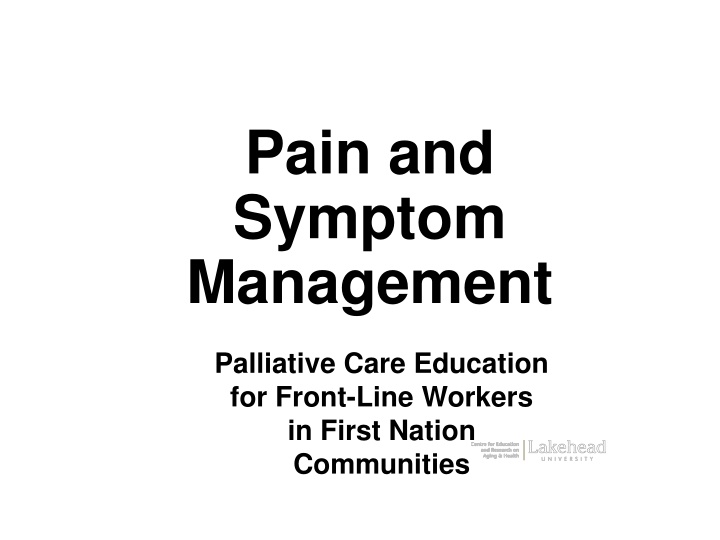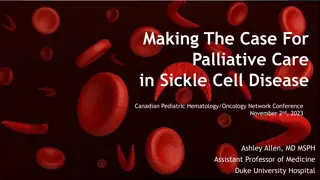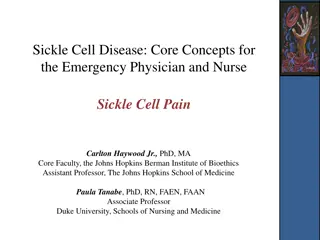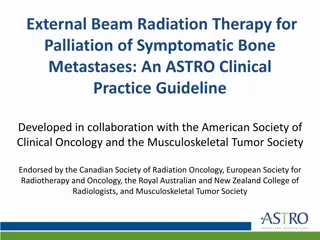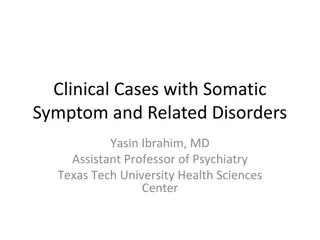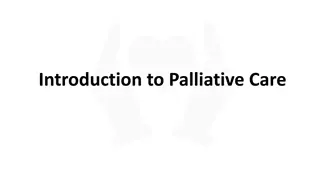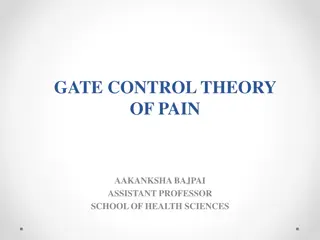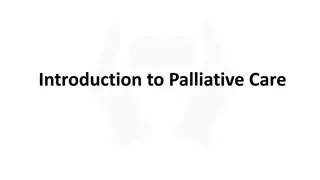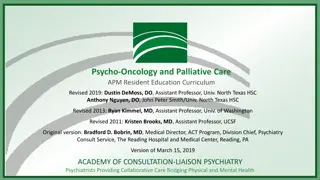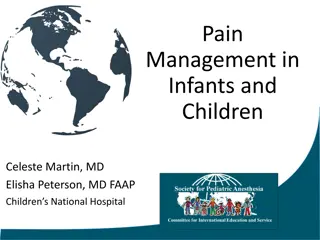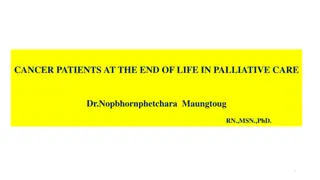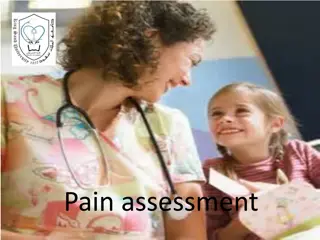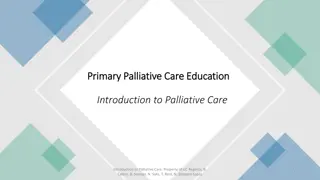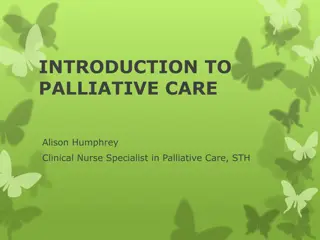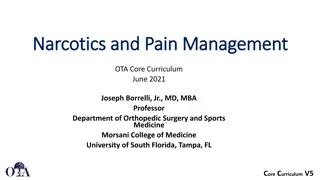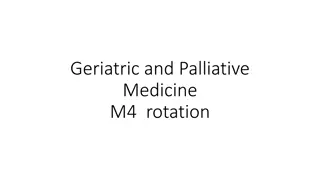Comprehensive Guide to Pain and Symptom Management in Palliative Care Education
Explore a comprehensive guide on pain and symptom management in palliative care education, emphasizing the importance of effective care plans and team participation. Learn about different types of pain, perception variations, and total pain factors affecting end-of-life care in First Nation communities. Gain insights from experts like Margo McCaffery on understanding and addressing pain for terminally ill individuals.
Download Presentation

Please find below an Image/Link to download the presentation.
The content on the website is provided AS IS for your information and personal use only. It may not be sold, licensed, or shared on other websites without obtaining consent from the author.If you encounter any issues during the download, it is possible that the publisher has removed the file from their server.
You are allowed to download the files provided on this website for personal or commercial use, subject to the condition that they are used lawfully. All files are the property of their respective owners.
The content on the website is provided AS IS for your information and personal use only. It may not be sold, licensed, or shared on other websites without obtaining consent from the author.
E N D
Presentation Transcript
Pain and Symptom Management Palliative Care Education for Front-Line Workers in First Nation Communities cerah.lakeheadu.ca
A few assumptions A good care plan can almost always alleviate pain Every member of the care team has a responsibility to participate in pain management It is impossible to have high quality end-of-life care when a person is in pain People facing death have a profound fear of pain
Pain is whatever the person experiencing it says it is, and it exists wherever the person says it does . - Margo McCaffery, nurse and pain management expert
Pain Belongs to the person Is enough to make them uncomfortable Caring for the Terminally Ill: Honouring the Choices of the People, p. 55-57
Acute pain Easier to recognize than chronic pain Examples: broken bones, sudden abdominal pain CHPCA, 2008
Chronic pain Examples: arthritis, tooth decay, osteoporosis Often more challenging to diagnose and treat than acute pain
Breakthrough pain Pain that re-emerges before the next dose of pain medication A spontaneous episode or manifestation of pain experienced by the person even though s/he is taking regular pain medication www.cerah.lakeheadu.ca
Perception of and response to pain will vary depending on: The meaning of pain to the individual Prior experience with pain Cultural background Age and gender
Total pain An individual may experience total pain from: the actual physical pain of the disease process intellectual pain from knowledge (or lack of knowledge) of her/his condition and prognosis emotional pain from feelings of anger or loneliness spiritual pain arising from the awareness of impending death
Myths and misconceptions (1 of 2) Health care providers are the experts on assessing pain and determining if pain is real Opioids should only be used for the management of cancer pain Opioid addiction (psychological dependence) is common in people taking opioids for treatment of moderate to severe pain
Myths and misconceptions (2 of 2) Opioid tolerance develops rapidly, necessitating progressively higher doses If one opioid doesn t work for a patient, none of them will
Emotional pain Symbolizes threats the individual is facing Is a constant reminder of the seriousness of the situation Change in the pain may mean the disease is progressing Pain may lead to fears Klee, 2004
Psychological pain Pain may cause depression The stress of pain may cause anxiety Anxiety and depression often aggravate pain Klee, 2004
Existential Pain (1 of 2) It is not unusual for pain to provoke existential questions regardless of the individual's religious and spiritual background Pain may make it difficult to find the peace of mind needed to think through complicated issues Klee, 2004
Existential Pain (2 of 2) The pain may be seen as a punishment Existential suffering may provoke strong emotions that aggravate the pain, making it more difficult to alleviate Klee, 2004
Social pain The family will be affected by the individual s pain They may experience feelings of helplessness, hopelessness Pain may result in social isolation Unresolved family issues may surface (Klee, 2004) www.cerah.lakeheadu.ca
Some barriers to treating pain The myth that pain is to be expected and that pain cannot be managed Patient factors Caregiver factors System factors The most common barrier is caregiver failure to ask about and assess pain
Three pain myths Addiction Tolerance Hallucination Caring for the Terminally Ill: Honouring the Choices of the People, p. 58-59
Pain Characteristics Ways to describe pain Aching Dull Sore Shooting Burning Stabbing www.cerah.lakeheadu.ca
Signs of pain (1 of 2) Grimacing or wincing Bracing (i.e. holding an arm) Guarding/protecting painful area Rubbing Changes in activity level Sleeplessness, restlessness Resistance to movement Withdrawal/depression Decreased appetite CHPCA, 2008 www.cerah.lakeheadu.ca
Signs of pain (2 of 2) General body tension (clenched hands, hunched shoulders, etc.) Tense facial expressions Constant fidgeting or nervous habits such as lip-biting Unexplained withdrawal Strained or higher-pitched tone of voice Increased agitation, anger, etc. www.cerah.lakeheadu.ca
Vocalized pain cues Words or statements such as ouch, or that hurts Verbal protests during care or transfers Moans Cries
When to observe for pain During personal care During transfers and walking Following activities At appropriate intervals after administering pain management interventions
Support Worker role in pain management Ask the individual if they are experiencing pain Watch for signs of pain Observe for side effects of medications Re-assess to evaluate the effectiveness of therapies Administer non-drug treatments Advocate for persons in pain Caring for the Terminally Ill: Honouring the Choices of the People, p. 57
Non-drug Interventions Physical (1 of 2) Massage Cold Heat Complementary Therapy (i.e.. massage) Positioning Exercise Caring for the Terminally Ill: Honouring the Choices of the People, p. 61- 64
Non drug interventions Psychological (2 of 2) Distraction Relaxation Music Comfort foods Imagery Controlled breathing
Advantages of non-drug interventions Low cost Less potential for negative side effects Decreases emotional response to pain Provides clients with a sense of control or involvement
Pain is a more terrible lord of mankind than even death itself. - Albert Schweitzer
